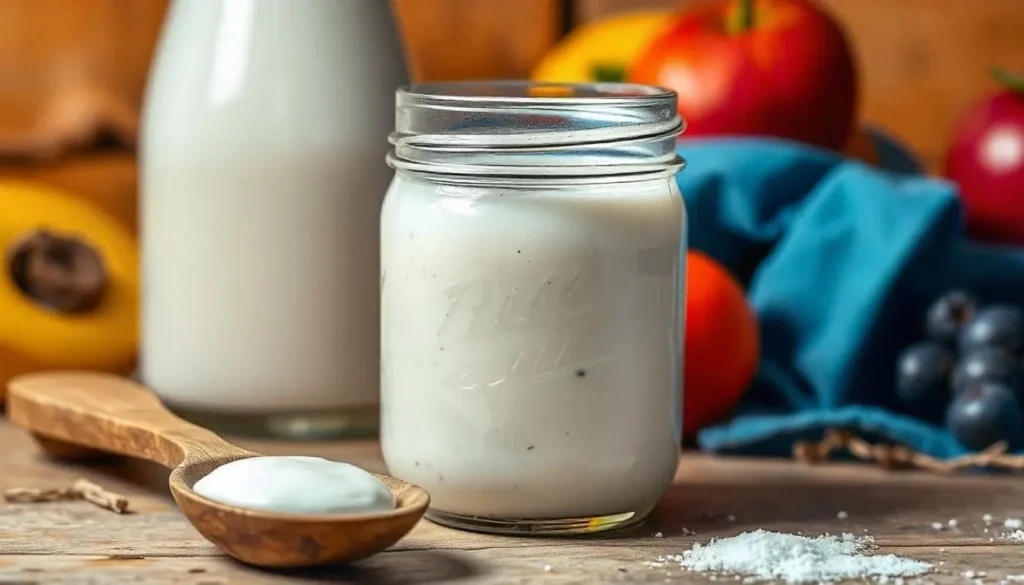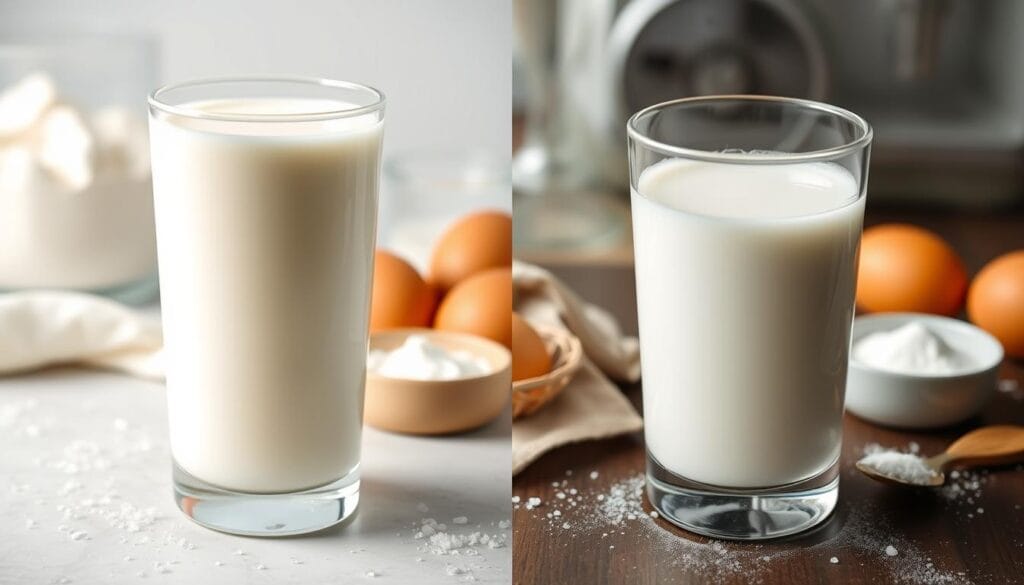
Last summer, I was baking a cake that needed buttermilk. But, my fridge was empty. I saw the kefir in my fridge and thought, “Why not try it?” This sparked my interest in using kefir as a buttermilk substitute.
Have you ever been in a baking emergency without buttermilk? Kefir, a fermented dairy, can be a great buttermilk substitute. It adds special qualities that can change your baking, even without buttermilk.
More and more, people are using kefir in baking. It’s a healthy and flexible choice for when you can’t find buttermilk. Learning how to use kefir can make your baking adventures more exciting.
Table of contents
Understanding Buttermilk and Kefir: A Comparative Look at Buttermilk Substitute
Fermented dairy products like buttermilk and kefir are getting more popular. They are both probiotic drinks with unique nutritional benefits and ways of making. Even though they both use lactic acid bacteria, they are quite different. This can affect your diet and cooking.

Traditional Buttermilk: Origins and Characteristics
Buttermilk used to be a leftover from making butter. Now, it’s a cultured dairy product with a tangy taste. It’s made by adding special bacteria to milk.
- Lower fat content (around 2.2 grams per serving)
- Mild flavor profile
- Rich in calcium and vitamin B12
- Typically contains around 99 calories per serving
Kefir: A Unique Fermented Drink
Kefir comes from the Caucasus Mountains. It’s a complex fermented dairy product. It’s made with special grains that have bacteria and yeast. This drink has been around for about 6,000 years.
- Higher protein content (around 10 grams per serving)
- More intense sour and tangy flavor
- Diverse probiotic composition
- Contains approximately 150 calories per serving
Key Differences Between Buttermilk and Kefir
| Characteristic | Buttermilk | Kefir |
|---|---|---|
| Consistency | Thin, milk-like | Thicker, more viscous |
| Probiotic Content | Lower concentration | Higher, more diverse microbial profile |
| Fermentation Process | Longer, lower temperature | Shorter, higher temperature |
Knowing these differences helps you choose the right fermented dairy product for your diet and cooking.
The Science Behind Using Buttermilk Substitute in Baking
Baking chemistry is a world where ingredients mix in complex ways to make tasty treats. Knowing how acidic ingredients like buttermilk work can improve your baking. It can make your cakes better.
Chemical Reactions with Leavening Agents
Buttermilk is key in making leavening agents work. When it meets baking soda, a cool chemical reaction happens. This reaction creates carbon dioxide bubbles. These bubbles make your cake light and fluffy.
- Acidic environment triggers rapid carbon dioxide production
- Enables better rise and improved cake structure
- Creates microscopic air pockets for tender crumb
Impact on Cake Moisture and Texture
Buttermilk does more than just help with rising. Its acidity breaks down gluten, making cakes soft and tender. It also keeps baked goods moist and delicious.
“The secret to a perfect cake lies in understanding the chemistry of its ingredients.” – Baking Expert
Acidity’s Critical Role in Cake Baking
Acidic ingredients like buttermilk do more than add a tang. They work with other ingredients to make a balanced, tasty cake. The acidity balances out strong flavors and brings out the cake’s subtle tastes.
| Ingredient Property | Baking Impact |
|---|---|
| Buttermilk Acidity | Activates Leavening Agents |
| Protein Breakdown | Tenderizes Cake Crumb |
| Moisture Content | Enhances Cake Softness |
Can I Use Kefir as a Buttermilk Substitute in Cake?
Baking fans often ask about using kefir in cake recipes. The good news is yes, you can use kefir as a buttermilk substitute. This fermented dairy product has special qualities that make it a great choice.
Kefir adds many benefits to your baking. Its high acidity and probiotics make it perfect for cake recipes. It helps cakes rise and makes them tender and moist.
“Kefir is not just a substitute—it’s a secret weapon in cake baking!” – Professional Baker’s Insight
Here are important tips for using kefir in cakes:
- Use a direct 1:1 ratio when replacing buttermilk
- Expect a slightly more robust flavor profile
- Potential for enhanced moisture retention
- Helps weaken gluten formation for softer cakes
| Kefir Characteristic | Baking Impact |
|---|---|
| Higher Acidity | Better Leavening |
| Probiotic Content | Improved Batter Consistency |
| Thick Texture | Enhanced Moisture |
Kefir adds nutritional value to your cakes. Packed with B vitamins, calcium, and protein, it makes baking healthier. Professional bakers love it for creating soft, tasty cakes with a unique flavor.
Properties of Kefir That Make It a Great Buttermilk Substitute
Kefir is a standout ingredient in baking, thanks to its unique properties. It’s a fermented milk product that rivals traditional buttermilk. Bakers find it an excellent choice for their recipes.
Kefir’s Remarkable Acidity Levels
Kefir’s acidity is key in baking. The fermentation process gives it a tangy taste, just like buttermilk. This makes it perfect for baking, ensuring your cakes rise well.
- Contains up to 25-30 billion probiotic Colony Forming Units
- Provides natural tanginess similar to buttermilk
- Supports chemical reactions in baking
Moisture and Texture Considerations
The right dairy can greatly affect a cake’s moisture. Kefir’s creamy texture adds richness to baked goods. Its protein structure makes the crumb tender and moist, keeping cakes fresh.
“Kefir can keep baked goods moist for extended periods due to its natural acidity and creaminess.”
For the best results, use kefir and buttermilk in equal parts. This versatile fermented milk adds depth to your baked goods.
How to Substitute Kefir for Buttermilk: Proper Ratios for a Buttermilk Substitute
When you’re looking to swap out ingredients in baking, knowing the right ratio is key. Kefir is a great dairy substitute that works well in place of buttermilk in many recipes.
The basic rule is simple: use a 1:1 ratio. If your recipe calls for a cup of buttermilk, just use a cup of kefir instead. This easy swap makes kefir a great choice for bakers.
“Baking is about precision, but it’s also about creativity” – Unknown Baker
Remember, kefir might be a bit thicker than buttermilk. If it’s too thick, you can thin it out:
- Add a splash of milk to get a buttermilk-like texture
- Whisk the kefir gently for a smoother feel
- Adjust other liquids if needed
Here’s a quick guide to help with these substitutions:
| Ingredient | Substitution Ratio | Consistency Adjustment |
|---|---|---|
| Kefir | 1:1 with buttermilk | Add milk if too thick |
| DIY Buttermilk | 1 tbsp acid + 1 cup milk | No additional adjustment |
| Yogurt | 1:1 with buttermilk | Thin with milk if needed |
Pro tip: Start with a small batch when trying new baking swaps. This way, you can get the best results for your recipe.
Impact on Cake Texture and Flavor When Using a Buttermilk Substitute
Swapping buttermilk for kefir in your baking brings interesting changes. The cake’s texture and taste get a unique twist. This makes your baking results stand out.
Exploring Crumb Structure Changes
Kefir gives your cakes a special texture. It makes the cake crumb denser than buttermilk recipes. This is due to kefir’s thicker consistency and probiotics.
- Denser cake structure
- More compact crumb texture
- Enhanced moisture retention
Flavor Profile Transformations
Kefir-based cakes have a more complex taste. The tanginess of kefir adds a subtle depth. This is great for cakes with chocolate or fruit.
“Kefir doesn’t just change texture – it transforms the entire sensory experience of baking.”
The fat content of your kefir affects the baking results. Full-fat kefir makes cakes richer and more tender. They have a deep flavor.
Best Types of Cakes for Using a Buttermilk Substitute
Exploring kefir cake recipes opens up a world of delicious moist cake varieties. These cakes benefit from this unique fermented milk baking ingredient. Not all cakes are created equal when it comes to using kefir as a substitute for traditional dairy ingredients.
The best candidates for kefir substitution include:
- Coffee cakes with rich, dense textures
- Chocolate cakes that welcome tangy desserts
- Fruit-based cakes like lemon or berry variations
- Pound cakes and bundt cakes
- Spice cakes with warm flavor profiles
- Carrot cakes that complement subtle sourness
When selecting a cake recipe, consider the moisture-retaining properties of kefir. The fermented milk’s unique characteristics can transform your baking experience.
“Kefir brings a delightful tang and incredible moisture to traditional cake recipes.” – Baking Enthuasiast
Your cake’s success depends on understanding how kefir interacts with other ingredients. Chocolate and spice-based cakes shine when using kefir. The slightly sour notes enhance deeper flavor profiles.
| Cake Type | Kefir Compatibility | Flavor Enhancement |
|---|---|---|
| Chocolate Cake | Excellent | Rich, deep chocolate notes |
| Carrot Cake | Very Good | Complements warm spices |
| Lemon Cake | Perfect | Adds subtle tanginess |
Experiment with different kefir cake recipes to discover your perfect moist and flavorful creation!
Common Mistakes to Avoid When Substituting
Baking with kefir needs careful attention. It’s a versatile ingredient, but there are important tips for using it as a buttermilk substitute.
Temperature Considerations for Perfect Baking
Kefir temperature is key for good baking. Don’t use kefir straight from the fridge. Cold ingredients can mess up your recipe’s balance. Let your kefir warm up at room temperature for 15-20 minutes before mixing.
- Allow kefir to warm slightly before ingredient preparation
- Check kefir’s temperature with a kitchen thermometer
- Aim for a moderate room temperature around 68-70°F
Mastering Mixing Techniques
Overmixing batter is a big no-no. Kefir’s special properties mean you must mix carefully. Fold ingredients gently to avoid tough gluten.
“Gentle mixing is the secret to tender, delightful baked goods.” – Baking Experts
| Mixing Technique | Impact on Baked Goods |
|---|---|
| Overmixing | Tough, dense texture |
| Gentle folding | Light, tender crumb |
| Minimal stirring | Optimal texture and rise |
Kefir’s higher protein and thicker consistency might need recipe tweaks. Start with a 1:1 substitution. Be ready to adjust liquid amounts if necessary.
FAQs:
1. Can you use kefir instead of buttermilk in cake?
Yes, kefir can be used as a direct 1:1 substitute for buttermilk in cake recipes. It adds similar acidity and moisture, making cakes tender and flavorful.
2. What is a good substitute for buttermilk in a cake?
Kefir is an excellent substitute for buttermilk in cakes. Other options include a mixture of milk and vinegar or yogurt thinned with water.
3. Can kefir be used in baking?
Absolutely! Kefir is a versatile ingredient in baking. It works well in recipes that require moisture and acidity, such as cakes, muffins, and pancakes.
4. Does kefir taste like buttermilk?
Kefir has a tangy flavor similar to buttermilk, but it is slightly more robust and sour. This flavor can enhance baked goods with a unique depth.
Conclusion
Starting your baking journey with kefir opens up a world of tasty possibilities. It’s a great buttermilk substitute, making your cakes unique. The fermented dairy adds a special twist, bringing flavor and health benefits to your desserts.
Kefir does more than just taste good. It makes your cakes moist and tender, with a hint of tanginess. It’s perfect for making sheet cakes or layer cakes, adding a special touch to your baking.
Remember, baking is all about trying new things and knowing your ingredients. Even with small changes, kefir can make a big difference. You’ll find a new way to bake that’s full of flavor, texture, and health benefits.
Your kefir baking journey is just starting. It’s time to try new things, explore flavors, and make healthier desserts. With kefir, the world of baking is full of exciting possibilities.
